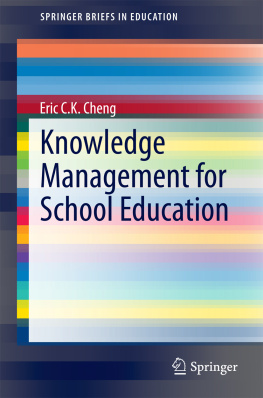Praise for Schools That Deliver
Im pleased to recommend Schools That Deliver as an exceptional workto inspire, rejuvenate, and engage your school staff along a powerfullyaligned trajectory toward success. Reimagine your school through the lens ofthese transformative authors.
Jill Gildea, Superintendent
Fremont School District 79
Mundelein, IL
Schools That Deliver is long overdue in the midst of too much focuson testing and accountability. It has the potential to provide a practicalguide coupled with the underlying philosophy to assist school leaders inmaking their schools engaging environments for all students and staff.
Richard A. Simon, Retired Superintendent of Schools, AdjunctProfessor
Stony Brook University and Long Island University Post
Stony Brook, NY
A common thread that separates Schools That Deliver from others isthe focus on remaining loyal to the unique personality of each individualschool while providing specific tools and procedures to focus on.
Delia McCraley, Principal
Southgate Academy
Tucson, AZ
John Edwards and Bill Martin write about the reality of authentic schoolissues using proven research and from their own experiences.
Bonnie Tryon, Mentor/Coach
SAANYS Representative to NYS Education Departments NCLB Committee ofPractitioners
SAANYS Representative to the NYS Teacher of the Year Council
Past President, School Administrators Association of New York(SAANYS)
Latham, NY
To Sandra and Vicki
Schools That Deliver
Foreword by
FOR INFORMATION:
Corwin
A SAGE Company
2455 Teller Road
Thousand Oaks, California 91320
(800) 233-9936
www.corwin.com
SAGE Publications Ltd.
1 Olivers Yard
55 City Road
London EC1Y 1SP
United Kingdom
SAGE Publications India Pvt. Ltd.
B 1/I 1 Mohan Cooperative Industrial Area
Mathura Road, New Delhi 110 044
India
SAGE Publications Asia-Pacific Pte. Ltd.
3 Church Street
#10-04 Samsung Hub
Singapore 049483
Copyright 2016 by John Edwards and BillMartin
All rights reserved. When forms and sample documents areincluded, their use is authorized only by educators, local school sites,and/or noncommercial or nonprofit entities that have purchased the book.Except for that usage, no part of this book may be reproduced or utilized inany form or by any means, electronic or mechanical, including photocopying,recording, or by any information storage and retrieval system, withoutpermission in writing from the publisher.
All trademarks depicted within this book, includingtrademarks appearing as part of a screenshot, figure, or other image, areincluded solely for the purpose of illustration and are the property oftheir respective holders. The use of the trademarks in no way indicates anyrelationship with, or endorsement by, the holders of said trademarks.
Printed in the United States of America
ISBN 978-1-5063-3347-2
This book is printed on acid-free paper.
Program Director: Dan Alpert
Senior Associate Editor: Kimberly Greenberg
Editorial Assistant: Katie Crilley
Production Editor: Melanie Birdsall
Copy Editor: Diane DiMura
Typesetter: C&M Digitals (P) Ltd.
Proofreader: Christine Dahlin
Cover Designer: Rose Storey
Marketing Manager: Charline Maher

Foreword
This book was written by two good friends of mine. They write about the joys andfrustrations, the successes and disappointments, the realities and dreams ofworking in learning organizations. In some ways, this book is a documentaryabout their sometimes brutal, often humorous and consistently touching realitiesas front-line school administrators. And in other ways, this book is about theirmission as educational provocateurs to draw upon their Personal PracticalKnowledge to liberate teachers, administrators, and students capacities forautonomous growth, learning, and adaptability: a noble cause.
I remember meeting John Edwards in 1982 at the first International Conference onThinking in Fiji. What struck me about this young Australian researcher were hisinsights about education and his daring to question and seek to transform manyof the sacred practices currently in vogue (such as homework,compartmentalization of subject matter, and theories of learning). During hissabbatical, I invited him to spend half a year with me at Sacramento StateUniversity. As a single parent, he came with his four children. The impact on mygraduate students was profound. Like the irritating grain of sand that creates apearl, he modeled risk taking, thinking critically about the educational statusquo and questioning practices that were politically correct but educationallyfaulty. As a result, my students gained confidence as agile leaders. Iintroduced John to consulting work and the response from schools was that Johnwas refreshingly sound. Since that time, John has matured from a brave,delightfully brash young man into a powerful, internationally respected,thinking changemaker.
In 1990, as principal of Bleyl Junior High School near Houston, Texas, BillMartin, complete with cowboy boots, invited me to spend time with his staff toexplore the teaching of Habits of Mind. I came prepared to introduce the staffto the need for teaching students to think more skillfully and how the Habits ofMind were dispositions of successful, efficacious thinkers that could be taughtand learned by students. Habits of Mind flourish in schools where there istrust, where staffs share a common vision, and where the Habits are not onlytaught but also modeled by all the staffwhere they are the norms of the school culture. Much to my amazement, Iwas greeted by the professional development lead teacher who introduced me tothe staffs motto: The United Mind Workers. Amazed, I put my plannedpresentation notes away, packed up my PowerPoints, and spent the next three daysobserving and learning from them. They were indeed united as they shared acommon vision, were committed to teaching thinking, and supported each other inthe process. They went far beyond my expectations due to Bills down-home,unassuming but powerful, leadership style. I learned how, working in conditionsof trust, being focused on students needs, having access to resources and givenfreedom, teachers will liberate their ingenuity and creativity to network,collaborate, and develop a vision that results in programs to which the entirestaff and community become committed. As a result, students dispositions ofpersisting, problem solving, collaborating, empathizing, questioning, andcontinual learning were enhanced.
Over the years, these two friends found each other, formed an alliance, and haveinfluenced school staffs and business leaders around the world. Based on theirleadership experiences, they are dedicated to a few simple but profound conceptswhich they articulate well for those who read, apply, and live by this book.


















